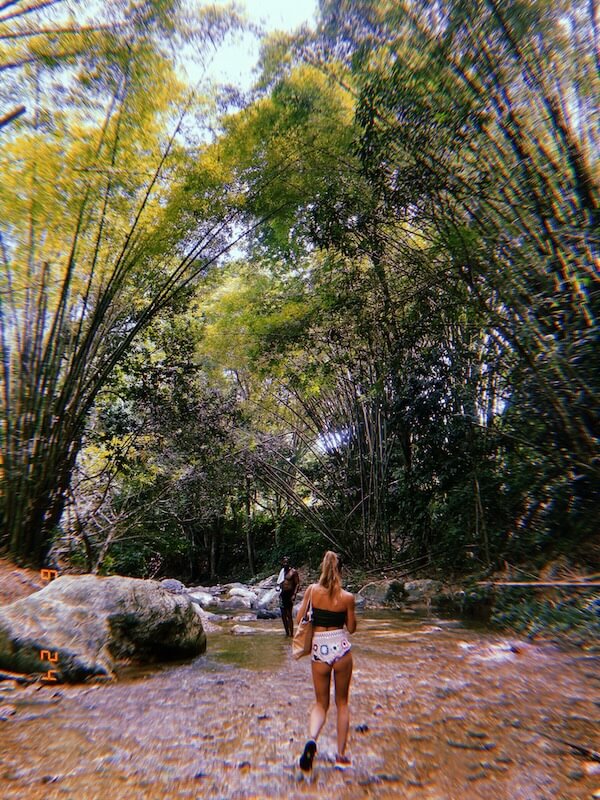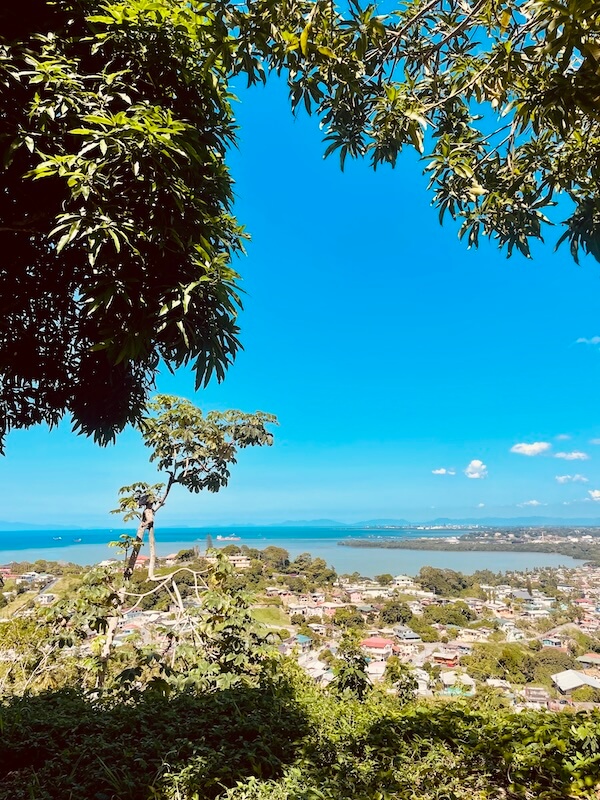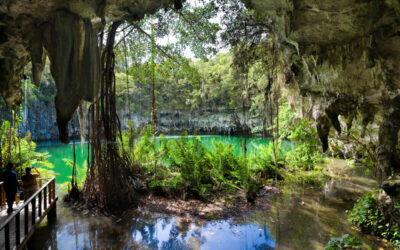Uncover the Hidden Treasures of Trinidad
Duration: at least one week
Budget: $ 150 per day
Where to stay: Culture Crossroads Inn or Kapok Hotel
Visiting Port of Spain and looking for the perfect day trip? As someone who’s spent a lot of time exploring this vibrant city and its surroundings, I can assure you there’s no shortage of adventures. Whether you’re a nature lover, interested in history, or just seeking some beachside relaxation, these day trips offer a mix of cultural, historical, and natural wonders. Here are my personal favorites with practical tips to help you make the most of your trip.
- Beaches 95%
- Historical sites 95%
- Nature adventures 95%
Port of Spain has a special place in my heart, not just because it’s full of life and culture but because it feels like home in a way no other city does—my boyfriend lives here. Walking its streets, I’m struck by the city’s rhythm, from the hum of street vendors selling doubles to the music that spills out of passing cars. The blend of vibrant neighborhoods, lively markets, and quiet moments at the Queen’s Park Savannah gives the city a personality that feels alive and authentic.
Northern Trinidad
Maracas Bay and the North Coast
If you’re craving sun, sand, and stunning views, Maracas Bay is a must! The drive alone is an adventure, winding through the lush Northern Range with jaw-dropping vistas. Once you reach Maracas, try the famous Bake and Shark. My favorite stall? Richard’s—their toppings bar is legendary. If you have extra time, continue along the coast to the quieter Las Cuevas or Blanchisseuse beaches.
- Travel time: About 1 hour from Port of Spain.
- Tips: Get an early start to avoid traffic and crowds. Don’t forget your sunscreen and cash for beach vendors.

Asa Wright Nature Centre
Nature enthusiasts, this one’s for you. Nestled in the Arima Valley, Asa Wright is a haven for birdwatchers and anyone who loves a peaceful retreat. I was mesmerized by the vibrant hummingbirds darting around the verandah—it’s pure magic.
- Travel time: Around 1 hour from Port of Spain.
- Tips: Book a guided tour to learn about Trinidad’s unique wildlife. Wear comfortable shoes and bring binoculars if you have them.
Paria Waterfall and Beach
For the adventurous, the hike to Paria Waterfall is challenging but incredibly rewarding. You’ll trek through the lush Northern Range, eventually reaching a serene beach and waterfall. It’s a true off-the-beaten-path experience.
- Travel time: About 1.5 hours to the hike’s starting point.
- Tips: Start early and bring plenty of water, snacks, and sturdy hiking shoes. This hike isn’t for beginners, so be prepared for a workout.
Mount St. Benedict Monastery
If you’re seeking tranquility, the Mount St. Benedict Monastery offers a peaceful escape with stunning panoramic views. The monks here also make delicious homemade yogurt, which you can’t miss!
- Travel time: Around 45 minutes from Port of Spain.
- Tips: Check out the hiking trails around the monastery for a gentle walk. Stop by the gift shop to support the monastery’s work.
Lopinot River
Tucked in the lush Lopinot Valley, this river spot is perfect for a refreshing dip surrounded by greenery. The area is steeped in history, with connections to French settlers and cocoa plantations.
- Travel time: About 1 hour from Port of Spain.
- Tips: Bring water shoes for better grip on the river stones and a picnic to enjoy by the riverbank.

Chaguaramas
Chaguaramas is a playground for outdoor lovers. Whether you’re hiking through the national park, exploring the fascinating Gasparee Caves, or zip-lining at Macqueripe Bay, there’s plenty to keep you active and engaged.
- Travel time: About 30 minutes from Port of Spain.
- Tips: Some activities, like the Gasparee Caves tour, require advance booking. Pack water and snacks for a full day of exploring.
- Travel time: Approximately 1.5 hours from Port of Spain.
- Tips: Wear sturdy shoes that can handle the lake’s sometimes sticky surface. Local vendors nearby sell handcrafted souvenirs.
Southern Trinidad

Pitch Lake
Did you know Trinidad is home to one of the world’s largest natural asphalt lakes? Visiting the Pitch Lake in La Brea is both fascinating and educational. The guided tours offer insight into the lake’s formation and its uses over the centuries.
- Travel time: Approximately 1.5 hours from Port of Spain.
- Tips: Wear sturdy shoes that can handle the lake’s sometimes sticky surface. Local vendors nearby sell handcrafted souvenirs.
San Fernando Hill
For panoramic views of Trinidad’s southern landscapes, San Fernando Hill is the perfect spot. It’s a peaceful place to enjoy a picnic and take in the scenery.
- Travel time: About 1.5 hours from Port of Spain.
- Tips: Bring a picnic blanket and some local snacks to enjoy while you take in the views.

Central Trinidad
Caroni Bird Sanctuary
For a breathtaking experience, head to the Caroni Bird Sanctuary. A boat tour through the mangrove swamps at sunset is unforgettable, especially when you see flocks of Scarlet Ibis returning to roost. The vivid red of the birds against the twilight sky is a sight I’ll never forget.
- Travel time: 30 minutes from Port of Spain.
- Tips: Evening tours offer the best birdwatching opportunities. Bring insect repellent and a camera with a good zoom lens.

Temple in the Sea and Waterloo
This Hindu temple, built on reclaimed land, is a symbol of resilience and faith. It’s a powerful cultural experience, especially when paired with a visit to the nearby Indian Arrival Monument.
- Travel time: Little more than 1 hour from Port of Spain.
- Tips: Visit during the late afternoon for cooler weather and beautiful sunset photography.
Practical Travel Tips for Trinidad and Tobago
Language: English
Currency: TT Dollar
How to get to Tobago
You’ve got two main routes—by air or by sea—and both kick off your island adventure the moment you step on board.
By Air
Fly into ANR Robinson International Airport (TAB) just outside Scarborough. Caribbean Airlines and several regional carriers operate daily hops from Port of Spain (about 25 minutes), plus flights from hubs like Barbados, Antigua and select North American gateways.
When you land, licensed taxis (look for plates beginning with “H”) wait curbside at fixed rates—or pick up your rental car right at the terminal and set your own pace (we drive on the left).
By Ferry
Head to the Port of Spain ferry terminal for a comfortable sea crossing—most services depart twice a day and take roughly 2½–3 hours.
On clear days you’ll dramatic coastal views as you glide toward Scarborough’s harbor. Make sure to bring movement sickness pills as you might get sick though the ferry is very comfortable.
What is the best time to visit Tobago?
Your description goes here. Edit or remove this text inline or in the description settings
Is Tobago safe?
Is Trinidad safe?
Having spent months exploring Trinidad’s peaks, rainforests and city streets, I can tell you it’s generally safe—locals are warm and welcoming, and most visits pass without a hitch. That said, it pays to use common sense, especially in busy urban areas. Here’s what’s worked for me:
Stay aware in Port-of-Spain: Petty theft (pickpocketing, bag snatches) can happen in crowded markets or on public transport. Keep valuables in front-facing bags or money belts.
Use licensed taxis: Look for yellow plates starting with “H” and agree your fare before you hop in. Ride-hailing apps like TT Uber work well in the city.
Avoid empty, poorly lit streets at night: Stick to well-lit main roads or take a trusted taxi if you’re out late.
Secure your accommodation: Use hotel safes or locked luggage for passports, extra cash and electronics.
Watch your drink: As at any party hotspot (hello, Carnival!), keep an eye on your glass and never leave it unattended.
Beach & nature safety: Beaches like Maracas and Las Cuevas have lifeguards; ask locals about currents before swimming. On hikes, go with a group or guide and carry water, a phone and a headlamp if you’ll be back after dark.
How to get around Tobago?
Tobago’s compact size means you’ve got plenty of options—pick what fits your style and budget. I kicked things off by hiring a driver to show me the ropes, and after a day or two, I felt confident enough to get behind the wheel myself.
Rent a car
Freedom to roam: Ideal once you know the roads—go at your own pace to hidden bays, waterfalls and hillside lookouts.
Left-hand driving: Road signs are clear but some back roads get narrow and winding—take it slow, especially after rain.
Tip: I started with a local driver for a day’s island tour, then rented a car so I could explore solo.
Maxi Taxis (shared vans)
Budget-friendly: Fixed routes between Scarborough, Crown Point, Morningstar and Charlotteville.
Hail and hop: They leave when full—just flag one down at a stand or on the roadside.
Cost: Roughly TT $8–15 per ride, depending on distance.
Private Taxis
Door-to-door service: Look for yellow plates starting with “H,” agree on the fare upfront.
Great for groups: Negotiate half- or full-day rates to tour the island with friends.
Scooters & Bikes
Quick runs: Perfect for short hops between nearby beaches and villages—watch for potholes and always wear a helmet.
Where to rent: Crown Point and Castara have rental shops.
Water Taxis & Boat Charters
Sea routes: Some operators connect Store Bay, Pigeon Point and Blue Waters by boat—ask locally for schedules.
Private charters: Ideal for beach-hopping, snorkeling stops or a sunset cruise.
On Foot
Walkable towns: Castara, Speyside and Scarborough are great for strolling—pop into a rum shop or local bakery.
Trails & hikes: Many waterfalls and ridge walks start as footpaths—bring sturdy shoes.
What are the challenges for the conscious traveler?
Trash. Street food almost always comes wrapped in aluminum foil, and many restaurants serve it in to-go boxes. Luckily enough, a foldable food container will go a long way.
Generally speaking, responsible tourism practices are not (yet) prevalent in Trinidad or Tobago. Therefore, wear eco-friendly sunscreen when visiting waterfalls and the beach.
Sunscreen: Protect Marine life and wear reef-friendly sunscreen!
Sunscreen: Protect Trinidads coast by using reef-friendly sunscreen.
How to move between Trinidad and Tobago?
You’ve got two straightforward options—by air or by sea—and both are easy to book:
By Air
Duration: About a 25-minute flight.
Airlines: Caribbean Airlines runs multiple daily flights between Piarco International Airport (POS) near Port of Spain and ANR Robinson Airport (TAB) outside Scarborough.
Booking: Reserve online or through travel agents; flights often fill up around Carnival and Christmas, so book early if you travel in peak season.
On arrival: Taxis, rental cars and maxi-taxis are all waiting curbside at TAB to whisk you to your Tobago base.
By Ferry
Duration: Roughly 2½–3 hours on a comfortable passenger catamaran.
Departure/Arrival: Ferries depart Port of Spain’s ferry terminal and arrive at Scarborough’s bay.
Schedule: Typically two sailings each way daily; times vary by operator so check online or call ahead.
Booking & Fare: Buy tickets at the terminal or online; fares are budget-friendly and you can bring a small amount of luggage onboard.
Can I drink tap water in Tobago?
Generally, yes—the public water supply in Tobago is treated and routinely tested, so it meets local safety standards. In most hotels, guesthouses and restaurants you’ll find the tap water is chlorinated and perfectly fine for brushing your teeth or making coffee.
That said, if you have a sensitive stomach—or you’re heading off the beaten path to remote bays—I prefer to stick to a UV water bottle just to play it safe. Here’s my rule of thumb:
In Scarborough, Crown Point & major resorts: Tap water is usually OK; feel free to refill a reusable bottle at a filtered-water station.
In villages or rustic eco-lodges: Opt for bottled water, especially if you’re unsure about the plumbing.
During heavy rains: Occasionally there can be brief turbidity or boil advisories—your accommodation or tour operator will let you know.
What languages ars spoken in Trinidad and Tobago?
Standard English: The official language used in government, schools, media and business.
Trinidadian Creole & Tobagonian Creole: English-based creoles used in everyday conversation, with distinct local flavors on each island.
Spanish: Widely taught in schools and spoken, especially in communities near the Venezuelan coast.
Trinidadian Hindustani: A Bhojpuri-derived dialect preserved mainly by older Indo-Trinidadian families and in cultural events.
French Creole (Patois): A small, older community still uses this French-based creole in rural villages.
Tamil: Spoken by some elderly members of the Tamil-heritage community.
Chinese Dialects: Hakka and Cantonese are common among Chinese-Trinidadians, with some Mandarin among newer residents.
Sign Languages: The indigenous Trinidad and Tobago Sign Language serves the local deaf community, and American Sign Language is also used in schools and by many deaf individuals.
Packing List Caribbean
Are you getting ready to travel to Trinidad and Tobago? Check out my packing list to come prepared. You’ll find anything from cloths to useful travel gadgets and eco friendly travel products!
Traveling Trinidad and Tobago?
Trinidad & Tobago ItineraryPlaces to visit in the Caribbean
Best places to stay in Jamaica
Where to stay in Jamaica- Saint Lucia at a Glance - Key areas - My Top Hotel Choices - North - South and Soufiere - East Coast - Castries - Budget Stays - Sustainable Stays - During Carnival - For couples -Beach StaysDuration: at least 3 weeks Best time to travel:...
Day trips from Santo Domingo
Explore 5 unforgettable day-trips from Santo Domingo—all within a 2-hour drive. Swim turquoise bays, explore limestone caves, wander medieval villages & vibrant local markets.
Where to stay in St. Lucia
Where to stay in Saint Lucia- Saint Lucia at a Glance - Key areas - My Top Hotel Choices - North - South and Soufiere - East Coast - Castries - Budget Stays - Sustainable Stays - During Carnival - For couples -Beach StaysDuration: at least 3 weeks Best time to...
Island Hopping St. Vincent
Join me as I island-hop through Saint Vincent’s gems—from Bequia to Union Island—in under an hour on budget-friendly boat rides that unveil hidden beaches, local flavors, and Caribbean charm.
Things to do in Bequia
Duration: at least 5 days Where to stay: The Liming Bequia Best time to travel: Dry Season: October-June; Festival Season: June to August Budget: $125 per dayBequia, the second-largest island in St. Vincent & the Grenadines, greeted me with an effortless calm the...
Things to do in Kingstown, St. Vincent and the Grenadines
Join me in Kingstown, St. Vincent as we wander the historic Botanical Gardens, clamber up Fort Charlotte, haggle at the bustling market, chase perfect sunsets, and savor local eats.
Chasing beaches in Portland, Jamaica
Craving sun-kissed days? My guide to the best beaches in Portland, Jamaica reveals Winnifred’s laid-back charm, Frenchman’s Cove’s dreamy lagoon & other local gems—straight from my own sandy-footed adventures.
15 Day Trips from Kingston | Mountains, Rivers & Beaches
When the hustle and bustle of Kingston becomes too much, escaping for a day-trip to one of the island’s nearby gems is the perfect remedy. Here are my favorite day trips from Kingston
Exploring the South of Trinidad: A Journey Through Hidden Gems
Exploring South Trinidad felt like uncovering a world of surprises—from the surreal La Brea Pitch Lake to quiet beaches and mouthwatering local flavors. In this guide, I share my personal experiences and travel tips to help you discover the magic too!
Driving in Trinidad: Why It’s Worth the Adventure
Driving in Trinidad gave me the freedom to explore breathtaking views, hidden spots, and remote beaches. In this guide, I share personal tips, favorite routes, and everything you need to know to confidently hit the road!










